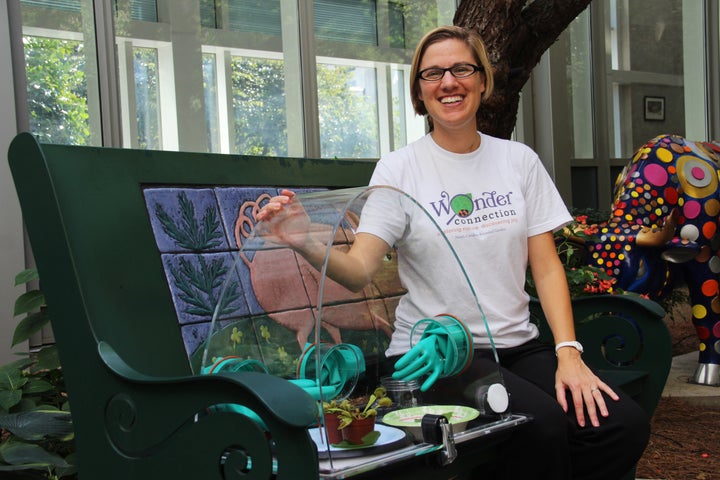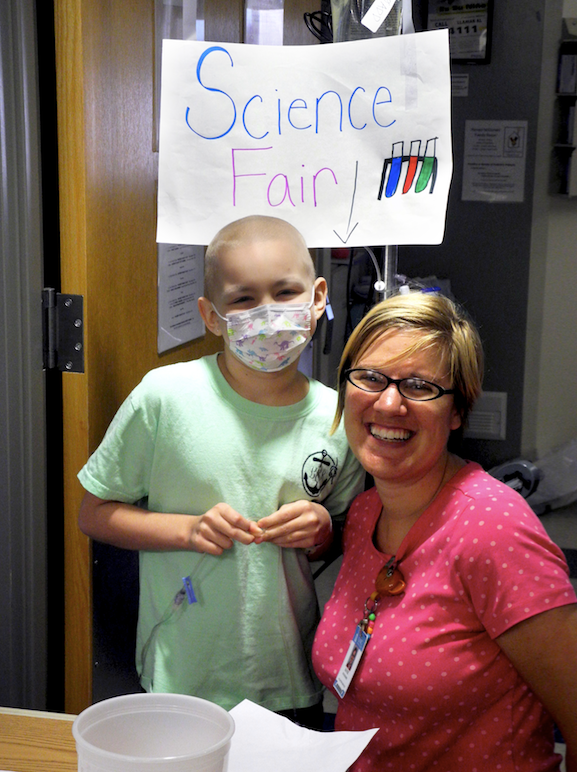When was the last time you checked in on your dreams? It’s easy to get distracted by the many creature comforts available these days. But if you stay focused on what really matters, what can’t you achieve?
In collaboration with TIAA, we’re shining a spotlight on a dreamer ― and doer ― supporting her local community through her organization, Wonder Connection. She’s proof positive that when you find your passion, and a mission with a higher purpose, anything is possible.
3, 2, 1 … Liftoff!
There’s mischief-making afoot in the halls of UNC Children’s Hospital in Chapel Hill, N.C., and at the center of the scheme is a 9-year-old boy undergoing an EEG.
He has help, of course, since the brain-scanning electrodes attached to his scalp confine him to a hospital bed for the day. A woman named Katie Stoudemire supplies the materials (film canisters and Alka-Seltzer tabs) and an ever-present, reassuring grin. Even the boy’s doctor gets enlisted, temporarily adding “lookout” to his list of credentials as he guards the doorway.
The coast is clear. With a signal from the M.D., Stoudemire and her young accomplice add water to the Alka-Seltzer tabs and firmly cover the lid of a canister, the boy squealing with happiness as yet another rocket shoots through the air.

Welcome to a typically atypical day in the life of Katie Stoudemire. In 2006, the 35-year-old founded Wonder Connection, a grant-supported program currently run through the North Carolina Botanical Garden at UNC-Chapel Hill, to help hospitalized children and teens foster a love of natural sciences through hands-on learning. Along with two staff members and a team of volunteers, she coordinates almost daily with the PreK-12 school located in the hospital to encourage patients to dive into fun, educational activities like microscope inspections, magnetic fishing and, of course, rocketry.
“I absolutely feel like I’m living the dream,” Stoudemire says.
Finding Her Passion
Stoudemire has worked tirelessly to connect sick children with extracurricular learning opportunities since before 2006, when the program was founded under the name “Healing and Hope Through Science.” The path she’s forged hasn’t always been straightforward, though. “When I was a kid, I thought I wanted to be a doctor,” the Atlanta native explains. As a lifelong lover of science, nature and children, the career path seemed to be a good fit, so much so that she went to Wesleyan University with the intention of hopping onto a pre-med track. “But then I realized that doctors don’t get to spend any time with the kids,” she laughs. “And I was like, ‘Oh, no, that’s my favorite part!’”
While at Wesleyan, Stoudemire volunteered at Connecticut Children’s Hospital and loved soothing babies with stories and songs. Children’s wards became a home base of sorts for her. Her cities shuffled ― she transferred from Wesleyan to North Carolina’s Davidson College, earning a bachelor’s in biology, and then began work at the Museum of Natural Sciences in Raleigh, N.C. ― but the hospital visits remained a constant, therapeutic throughline in her life. She soon realized she could combine the two worlds by bringing museum materials like seashells to her local children’s unit. But not until a nurse asked Stoudemire to encourage an unresponsive patient to eat her breakfast did the young volunteer realize what she’d stumbled onto.

“It just had an incredibly positive impact on her,” Stoudemire says of the moment she tucked the shells she’d brought with her into the patient’s right hand, watching the girl slowly come alive. “So I thought, yes, this is what I want to do.”
‘These Kids Want To Learn’
Today, Wonder Connection has come into its own as an organization supplementing the learning needs of pediatric and psychiatric patients ages 4 through 18. But it’s not easy work. Cancer, cystic fibrosis, cardiac defects, severe burns ― program participants are often fighting for lives that have only just begun. And with compromised immune systems that tend to go hand-in-hand with these illnesses, the children aren’t able to engage with Stoudemire’s bio-materials the way healthy peers might.
“We can’t even have floral bouquets on the unit because of the risk of infection,” explains Patricia Yee, a veteran nurse manager at UNC Children’s whose patients have participated in Stoudemire’s program since its inception. Tissue paper flowers, however, got the thumbs-up from hospital staff, so constructing them has become a favorite activity of Wonder Connection participants.
Stoudemire is always on the hunt for workarounds like this one. Her goal of safely bringing patients as close as she can to the outside world is what’s led to one her greatest accomplishments to date ― the WonderSphere.

The brainchild of a partnership between Stoudemire and Bresslergroup, a Philadelphia-based product design and engineering firm, the lightweight, airtight device allows immunocompromised children to handle flora and fauna like Venus flytraps and caterpillars without exposing them to dangerous microbes. The WonderSphere, which Stoudemire and Bresslergroup developed with input from the UNC Department of Epidemiology, is now a Wonder Connection staple, and has even won a national award for its innovative design and social impact.
“Katie just has this magnetic personality … she’s a bright light to them, these kids want to learn,” Yee says. One Wonder Connection participant undergoing chemotherapy for a brain tumor was decidedly driven in her pursuit of knowledge. Yee recalls, “She said, ‘Where’s that science lady? I really need to see that science lady. I’ve got work to do, I’m going into first grade!’
“It’s made them not be so different from their peers,” Yee continues. “There are so many things they can’t do, and this is something they can do.”
The Power Of Choice
If young pupils like this one can serve as any indication, Wonder Connection is a success. By their own count, they’ve served about 1,000 contact hours per year, engaging with 400 children annually since their start in largely one-on-one sessions. And in a 2013–2014 survey of 120 program participants, Stoudemire and her team found that students’ positive emotions increased from 64 percent to 88 percent ― an important shift if we take into account recent studies showing positive attitudes can help speed a patient’s recovery.
Doctors and nurses ably battle the afflictions of a child’s body, but don’t always have the time or resources to stave off the boredom, loneliness and powerlessness that comes with being restricted to a room for months on end. That’s why Stoudemire has made choice a pillar of her program, leaving the decision of whether and how to participate in Wonder Connection’s activities completely up to the children.
“I think giving the kids as many choices as possible is really important,” Stoudemire says of her approach. “Because when you’re in the hospital you hardly get any choices about anything.”

Next Stop, The World
Despite having her hands full raising her own son, 17-month-old Walden, alongside her pediatrician husband, Stoudemire has no plans to slow down on the Wonder Connection front anytime soon. Quite the opposite, in fact. With increased hospital hours, as well as a brand-new invention co-designed by the Bresslergroup slated to be shipped this fall ― a working model of a stream bed that she’s nicknamed “Hippo-ie” ― Stoudemire is moving toward her ultimate goal: seeing programs like Wonder Connection expand beyond UNC Children’s to hospitals worldwide. Because right now, “As far as I know, it’s just us,” she says.
And therein lies her current struggle. “The biggest challenge I’ve had in the past year,” she says, “has been how to figure out how to make the program financially sustainable so it can grow.”
It’s true that funding is a regular concern for an organization like Stoudemire’s. But the people in her life are sure there’s no one better suited to lead Wonder Connection forward. “She’s a very resourceful person,” Yee says warmly. “She is one of those unsung heroes.”
TIAA believes in celebrating those who serve others. Learn how other TIAA customers have pursued their own definitions of success.